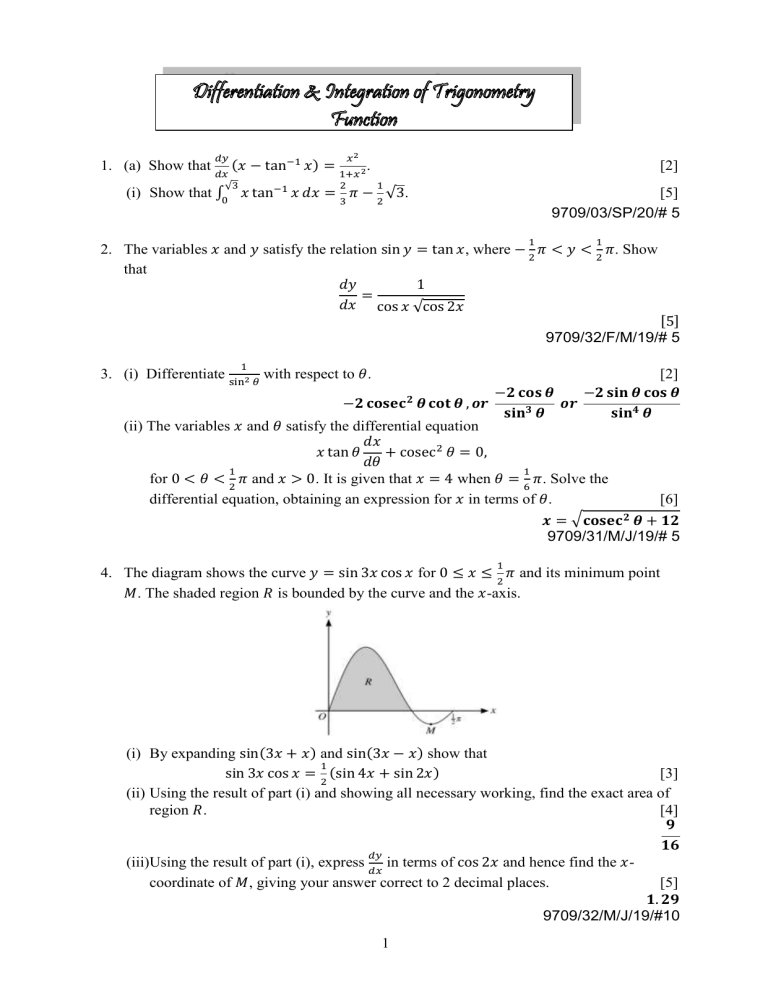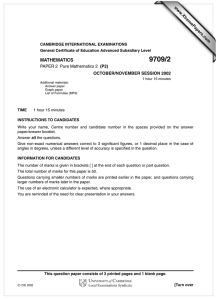20 21 Differentiation and Integration of Trigonometry Function 9709
advertisement

𝑥2 𝑑𝑦 1. (a) Show that 𝑑𝑥 (𝑥 − tan−1 𝑥) = 1+𝑥 2 . 2 √3 [2] 1 (i) Show that ∫0 𝑥 tan−1 𝑥 𝑑𝑥 = 3 𝜋 − 2 √3. [5] 9709/03/SP/20/# 5 1 1 2. The variables 𝑥 and 𝑦 satisfy the relation sin 𝑦 = tan 𝑥, where − 2 𝜋 < 𝑦 < 2 𝜋. Show that 𝑑𝑦 1 = 𝑑𝑥 cos 𝑥 √cos 2𝑥 [5] 9709/32/F/M/19/# 5 1 3. (i) Differentiate sin2 𝜃 with respect to 𝜃. [2] −𝟐 𝐜𝐨𝐬 𝜽 −𝟐 𝐬𝐢𝐧 𝜽 𝐜𝐨𝐬 𝜽 −𝟐 𝐜𝐨𝐬𝐞𝐜 𝟐 𝜽 𝐜𝐨𝐭 𝜽 , 𝒐𝒓 𝒐𝒓 𝟑 𝐬𝐢𝐧 𝜽 𝐬𝐢𝐧𝟒 𝜽 (ii) The variables 𝑥 and 𝜃 satisfy the differential equation 𝑑𝑥 𝑥 tan 𝜃 + cosec 2 𝜃 = 0, 𝑑𝜃 1 1 for 0 < 𝜃 < 2 𝜋 and 𝑥 > 0. It is given that 𝑥 = 4 when 𝜃 = 6 𝜋. Solve the differential equation, obtaining an expression for 𝑥 in terms of 𝜃. [6] 𝒙 = √𝐜𝐨𝐬𝐞𝐜 𝟐 𝜽 + 𝟏𝟐 9709/31/M/J/19/# 5 1 4. The diagram shows the curve 𝑦 = sin 3𝑥 cos 𝑥 for 0 ≤ 𝑥 ≤ 2 𝜋 and its minimum point 𝑀. The shaded region 𝑅 is bounded by the curve and the 𝑥-axis. (i) By expanding sin(3𝑥 + 𝑥) and sin(3𝑥 − 𝑥) show that 1 sin 3𝑥 cos 𝑥 = 2 (sin 4𝑥 + sin 2𝑥) [3] (ii) Using the result of part (i) and showing all necessary working, find the exact area of region 𝑅. [4] 𝟗 𝟏𝟔 𝑑𝑦 (iii)Using the result of part (i), express 𝑑𝑥 in terms of cos 2𝑥 and hence find the 𝑥coordinate of 𝑀, giving your answer correct to 2 decimal places. [5] 𝟏. 𝟐𝟗 9709/32/M/J/19/#10 1 1 5. The curve 𝑦 = sin (𝑥 + 3 𝜋) cos 𝑥 has two stationary points in the interval 0 ≤ 𝑥 ≤ 𝜋. (i) (ii) (iii) 6. (i) (ii) 𝑑𝑦 Find 𝑑𝑥 . [2] 𝟏 𝐜𝐨𝐬 (𝟐𝒙 + 𝝅) 𝟑 By considering the formula for cos(𝐴 + 𝐵), show that, at the stationary points on 1 the curve, cos (2𝑥 + 3 𝜋) = 0. [2] Hence find the exact 𝑥-coordinate of the stationary points. [3] 𝟏 𝟕 𝝅 𝒐𝒓 𝝅 𝟏𝟐 𝟏𝟐 9709/33/M/J/19/#7 By differentiating 1 𝜋 2 1 𝜋 4 cos 𝑥 sin 𝑥 𝑑𝑦 , show that if 𝑦 = cot 𝑥 then 𝑑𝑥 = − 𝐜𝐨𝐬𝐞𝐜 𝟐 𝒙. 1 Show that ∫ 𝑥 cosec 2 𝑥 𝑑𝑥 = 4 (𝜋 + ln 4). [2] [6] 9709/31/O/N/19/#6 7. The variable 𝑥 and 𝜃 satisfy the differential equation 1 𝑑𝑥 1 sin 𝜃 = (𝑥 + 2) cos 𝜃 2 𝑑𝜃 2 1 for 0 < 𝜃 < 𝜋. It is given that 𝑥 = 1 when 𝜃 = 3 𝜋. Solve the differential equation and obtain an expression for 𝑥 in terms of cos 𝜃. [8] 𝒙 = 𝟒 − 𝟔 𝒄𝒐𝒔 𝜽 9709/32/O/N/19/#6 8. The diagram shows the graph of 𝑦 = 𝑒 cos 𝑥 sin3 𝑥 for 0 ≤ 𝑥 ≤ 𝜋, and its maximum point 𝑀. The shaded region 𝑅 is bounded by the curve and the 𝑥-axis. (i) (ii) 9. (i) Find the 𝑥-coordinate of 𝑀. Show all necessary working and give your answer correct to 2 decimal places. [5] 𝒙 = 𝟏. 𝟐𝟔 By first using the substitution 𝑢 = cos 𝑥, find the exact of the area of 𝑅. [7] 𝟒 𝒆 9709/33/O/N/19/#10 Using the expansions of cos(3𝑥 + 𝑥) and cos(3𝑥 − 𝑥), show that 1 (cos 4𝑥 + cos 2𝑥) ≡ cos 3𝑥 cos 𝑥 2 [3] (ii) 1 𝜋 6 1 − 𝜋 6 Hence show that ∫ 3 cos 3𝑥 cos 𝑥 𝑑𝑥 = 8 √3. [3] 9709/32/F/M/18/#3 2 10. The variable 𝑥 and 𝜃 satisfy the differential equation 𝑑𝑥 𝑥 sin2 𝜃 = 2 tan 𝜃 + 1, 𝑑𝜃 1 1 for 0 ≤ 𝜃 ≤ 2 𝜋 and 𝑥 > 0. It is given that 𝑥 = 1 when 𝜃 = 4 𝜋. (i) (ii) 𝑑 Show that 𝑑𝜃 (tan2 𝜃) = 2 tan 𝜃 cos2 𝜃 . [1] 1 Solve the differential equation and calculate the value of 𝑥 when 𝜃 = 3 𝜋, giving your answer correct to 3 significant figures. [7] 𝒙 = 𝟐. 𝟓𝟒 9709/32/F/M/18/#6 11. A curve has equation 𝑦 = 𝑒 3𝑥 1 2 tan 𝑥 . Find the 𝑥-coordinates of the stationary points of the curve in the interval 0 < 𝜃 < 𝜋. Give your answer correct to 3 decimal places [6] 𝟎. 𝟑𝟒𝟎 𝒐𝒓 𝟐. 𝟖𝟎𝟐 9709/31/M/J/18/#3 3 4 1 4 𝑥 12. Let that 𝐼 = ∫ √1−𝑥 𝑑𝑥. 1 𝜋 3 1 𝜋 6 2 (i) Using the substitution that 𝑥 = cos 𝜃, show that that 𝐼 = ∫ 2 cos 2 𝜃 𝑑𝜃. (ii) Hence find the exact value of 𝐼. (iv) Find 𝑑𝑥 . [4] [4] 𝟏 𝝅 𝟔 9709/31/M/J/18/#5 1 13. The curve 𝑦 = sin (𝑥 + 3 𝜋) cos 𝑥 has two stationary points in the interval 0 ≤ 𝑥 ≤ 𝜋. (v) (vi) 14. (i) (iii) 𝑑𝑦 [2] 𝟏 𝐜𝐨𝐬 (𝟐𝒙 + 𝝅) 𝟑 By considering the formula for cos(𝐴 + 𝐵), show that, at the stationary points on 1 the curve, cos (2𝑥 + 3 𝜋) = 0. [2] Hence find the exact 𝑥-coordinate of the stationary points. [3] 𝟏 𝟕 𝝅 𝒐𝒓 𝝅 𝟏𝟐 𝟏𝟐 9709/33/M/J/19/#7 By differentiating 1 𝜋 2 1 𝜋 4 cos 𝑥 𝑑𝑦 , show that if 𝑦 = cot 𝑥 then 𝑑𝑥 = − 𝐜𝐨𝐬𝐞𝐜 𝟐 𝒙. sin 𝑥 1 Show that ∫ 𝑥 cosec 2 𝑥 𝑑𝑥 = 4 (𝜋 + ln 4). [2] [6] 9709/31/O/N/19/#6 15. The variable 𝑥 and 𝜃 satisfy the differential equation 1 𝑑𝑥 1 sin 𝜃 = (𝑥 + 2) cos 𝜃 2 𝑑𝜃 2 1 for 0 < 𝜃 < 𝜋. It is given that 𝑥 = 1 when 𝜃 = 3 𝜋. Solve the differential equation and obtain an expression for 𝑥 in terms of cos 𝜃. [8] 𝒙 = 𝟒 − 𝟔 𝒄𝒐𝒔 𝜽 9709/32/O/N/19/#6 3 16. The diagram shows the graph of 𝑦 = 𝑒 cos 𝑥 sin3 𝑥 for 0 ≤ 𝑥 ≤ 𝜋, and its maximum point 𝑀. The shaded region 𝑅 is bounded by the curve and the 𝑥-axis. (iii) Find the 𝑥-coordinate of 𝑀. Show all necessary working and give your answer correct to 2 decimal places. [5] 𝒙 = 𝟏. 𝟐𝟔 (iv) By first using the substitution 𝑢 = cos 𝑥, find the exact of the area of 𝑅. [7] 𝟒 𝒆 9709/33/O/N/19/#10 4



